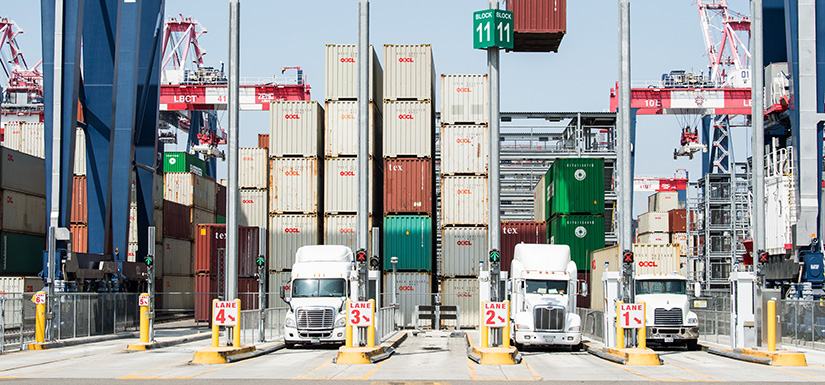Airports, Seaports, and Inland Ports Modernization
NLR researchers provide airports, seaports, and inland ports with comprehensive strategies to improve the affordability and performance of vehicles, vessels, and cargo-handling equipment as well as their connections to the grid.
We provide insights to support ports' strategic deployment of advanced vehicles, charging and refueling infrastructure, and the grid improvements necessary to provide convenient, reliable, cost-effective electricity at scale.

Airport Modernization
NLR provides airports with tools and data to support cost-effective integration of advanced technologies.
Leveraging the laboratory's powerful Advanced Research on Integrated Energy Systems research platform, our researchers develop sophisticated strategies to support electrification of passenger, rental fleet, and airport-owned vehicles that operate in and around airports.
After analyzing existing vehicle operations, NLR researchers provide tailored recommendations to gradually phase in the advanced vehicle and equipment solutions of best fit. These site-specific recommendations include electric, hydrogen fuel cell, and biofuel vehicles, along with the infrastructure and grid upgrades needed to support them.
These efforts are driving substantial modernization efforts at airports, such as Dallas Fort Worth International Airport, and across the nation.
Inland and Seaport Modernization
For nearly two decades, NLR researchers have worked toward comprehensive energy-saving efforts at some of the busiest inland ports and seaports in the nation.
Our researchers conduct deep analysis into port vehicle operations—including drayage vehicles, port yard tractors, harbor cranes, forklifts, cargo handling equipment, tugboats, and vessels—and deliver customized strategies to transition these vehicles to next-generation models.
Our strategies include infrastructure planning for electric vehicle charging; shore power transfer; hydrogen generation, storage, infrastructure requirements, and fueling; and integration of electrified vehicles and equipment with port facilities, energy storage systems, and the grid.
NLR's work doesn't stop at the port's gates: Our researchers can plan regional infrastructure to support port activities, such as freight corridor infrastructure plans, infrastructure for interconnected port facilities, and mobility solutions for urban planners. We integrate public health considerations into our work by quantifying the impacts of improved air quality on the communities surrounding seaports and inland ports.
Emerging Marine Vessel Technologies
NLR researchers are charting the path to advanced maritime freight technologies by exploring innovative marine vessel powertrains.
Using NLR's MARINESim: Maritime Analysis of Resources and INtegrated Energy Simulation, we analyze operational data from marine vessels and create powertrain models for both conventional and emerging fuel systems. Then we pinpoint the solution of best fit, including plug-in hybrid systems, electric systems, and next-generation fuels. Our portfolio spans ferries, tour boats, tugboats, and fishing vessels in addition to exploring the potential for future-proofed marine corridors.
Aviation Electrification
As advanced technologies spread to the skies, NLR researchers are driving progress on the aircraft and airports of the future. This includes exploring efficiencies and new energy carriers for existing and new conventional aircraft.
Using our advanced aviation modeling and simulation tools, companies can understand the performance limitations and potential infrastructure needs of emerging aircraft technologies.
Our rapidly expanding aircraft modeling tools build upon years of research looking at all forms of on- and off-road travel that concentrate at airports, including buses, transportation network companies, aircraft ground service equipment, and rental fleets. We continue to develop and enhance accessible tools for ground vehicle modeling to quickly and easily compare powertrains; estimate the impact of technology improvements on fuel and energy use, performance, cost, and battery life; and assist in sizing infrastructure to ensure cost-effectiveness.
Our modeling and analysis have informed strategic blueprints for resilient airports, military bases, and vertiports.
Publications
Aviation Energy Research and Operation Simulator (AEROSim), NLR Fact Sheet (2024)
Federal Aviation Administration Vertiport Electrical Infrastructure Study, NLR Technical Report (2023)
Port of New York and New Jersey Drayage Electrification Analysis, NLR Technical Report (2022)
Ontario International Airport Fleet Electrification Blueprint, NLR Presentation (2022)
Electrification of Aircraft: Challenges, Barriers, and Potential Impacts, NLR Technical Report (2021)
Energy Modeling for Fishing Boat Hybridization, TechRxiv (2024)
Contact
To learn more about our airports, seaport, and inland port research or explore partnership opportunities, please reach out.
Share
Last Updated Dec. 7, 2025
